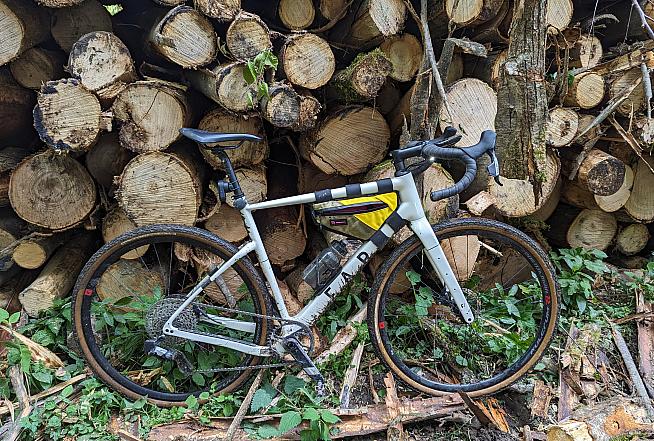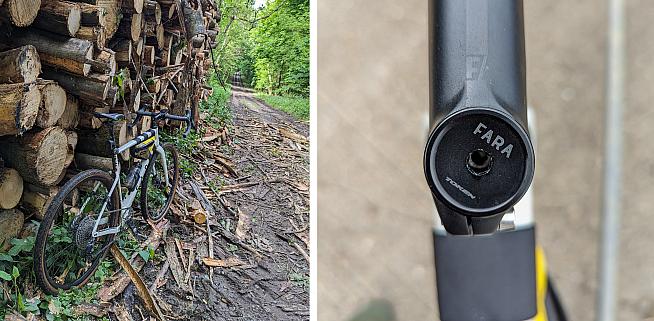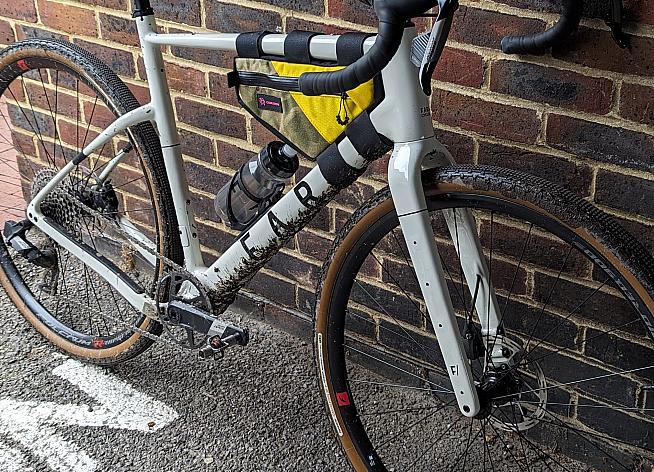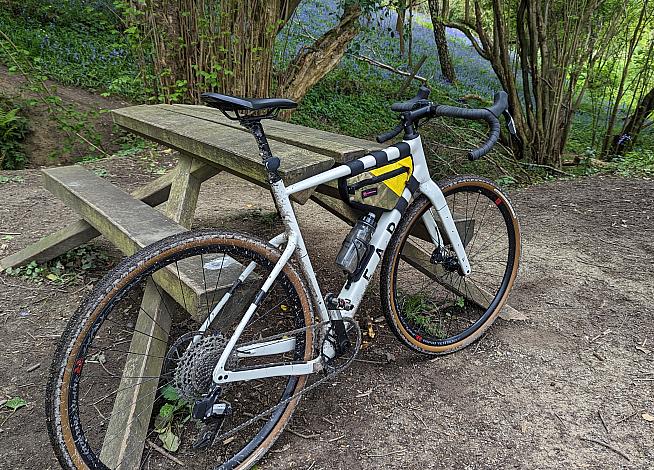This time last year, I had three steel-framed bikes and never thought I'd ever entertain thoughts of going back to alloy or plastic as a material to ride on. But the seeds of a mid life crisis-level event were sown in my psyche by the loan of a superb Fara F/All Road, and the freedom of an extended epic ride around Isle of Wight.
I had set up my camper in the New Forest and had plans to do two rides in two days, one off-road and the other on tarmac. Two things happened to dampen my spirit. Physically I'd burnt all my matches on my circumnavigation on the first day, and two days of constant 'English Summer' piddled on my enthusiasm chips.
Cyclists continually live with the disappointment of days being rained off, and I had convinced myself that the lead in my legs was the effect of my birthday celebrations a few days earlier.
But I loved the Fara so much that I enquired after a frameset to load with the inevitable cache of premium bike spares that tinkerers like me tend to squirrel away in sheds and garages.
Sadly it was out of my price range at the time. Fortunately for my bank balance, I had acquired a Giant Revolt that I could carve out in an F/All Road homage.
Try as I might though, I couldn't replicate the feeling of completeness I got when riding the Fara. I did, however, manage to build a proper, feather-weight gravel bike and I imagined that was what the F/All Road would have felt like if I'd had the chance to do a 'proper' off-roader on it.
What it actually did was make me realise I'd loved the Road element more than the All (single-track & bridleway), and would probably end up resentful for the feeling of compromise that I'd felt with the F/All Road.

At any rate, my what-ifs have been soundly put to bed by an opportunity to ride Fara's F/Gravel over the last few weeks.
This is Fara's answer to the question "What if I want to go wild?": any road-biased compromise has been ironed out with greater tyre clearance and the in-saddle view of the fork reveals some serious daylight around the front wheel.
I sighed slightly when I noted that a £3K bike had seemingly been specced with SRAM's entry level Apex groupset - but a double take at the rear revealed this was in fact the new Apex XPLR AXS group, a new entry into the future of wireless electronic shifting.
Entry level is relative, and this Apex rendition of AXS felt mechanically (or should that be wirelessly) identical to my experience with the Force and Rival versions I'd previously ridden with.
As with all versions of AXS, all components are seamlessly integrated and are up- and downwardly compatible and scalable, meaning any upgrades can be done in modules, or cheaper levers/mechs can be substituted when budget is limited.
The remainder of the spec is on par with the rest of the range - Ritchey bar and stem are very nice, although I'm not a fan of the slight back sweep and the integrated stem cap wasn't lined up with the maker's name - a common neurosis with some cyclists. That and not lining the logos on your tyres with the valve stems. My skin is itching at the very thought of it...


Sitting on the F/Gravel for the first time felt vaguely familiar but I was a bit worried at the twitchy handling and sluggishness. It wasn't until I did an additional M-check that I realised I'd forgotten to check the tyre pressures and I was basically running my tyres on their rims.
A few pumps later - my red face was purely due to the inflation, honest - and the experience turned out infinitely better. The GravelKings that shod the Fulcrum Rapid Reds are a great tyre for country roads and bridle paths, but after a particularly sodden spring, weren't best suited to off-road endeavours in the Weald. A chunkier tread would have stopped so much side-to-side movement for me.
The SRAM Apex performed admirably, although the S300 brake calipers reached their limit just short of me soiling my underwear on a couple of bumpy singletrack descents.
I was initially concerned about the gearing set-up for the one-by - the XPLR rear mech has a 44T limit - but my fear of running out of ratios appeared baseless.
The weight improvement over my normal 10-50 x 40T meant that the 10-44 x 42T was adequate for all but the steepest of my local climbs. I did find selecting a comfortable ratio for my desired cadence hard at first, being used to a 40T chainring, and would certainly consider sizing down to a smaller chainring for loaded mountain touring.
Speaking of weight, Fara claim the F/Gravel frame comes in at 1050g. That should allow for some very lightweight builds, depending on choice of groupset, wheels and finishing kit.

Aside from the changes to tyre clearance - the Fara F/Gravel can take 700x50mm tyres - there are other more adventure-oriented changes on show here. There are still some of their excellent magnetic luggage mounts for Fara's custom frame and saddle bags, and an abundance of mount points for bottle cages, fork bags and everything else for those who want to pack everything up to the kitchen sink.
A new and welcome addition is a SWAT-like hidey-hole (Fara call their design the Stash Hatch) in the down tube, similar to that found on the Trek Domane, Canyon Grail and an increasing number of adventure-oriented bikes.
In theory it's a useful space to tuck away an inner tube and repair kit, although my fellow Sportive.com contributor, Chris, owns the F/Gravel and has reported some issues with the cover of this hatch. Happily Fara have been quick to send out replacements, and the current, third iteration seems to be more secure.
Another thing that caught my eye was a novel way to mount the front brake caliper, bolts going through the fork and into either a 160mm caliper or an adaptor similar to the way most rear disc brakes are mounted.
I'm not a fan of the resulting aesthetics, but that's about my only quibble on that score: the F/Gravel is a sleek machine. I'm not normally a fan of lighter-coloured livery, but the off-white gloss finish has an understated brilliance.
For home mechanics like myself the F/Gravel has generally been designed to make life easy: from the T47 threaded bottom bracket, to the standard 27.2 round seatpost, there's very little by way of proprietary or esoteric weirdness as far as spec is concerned.
The one exception is the internal cable routing through the headset, but even this has been implemented with a standard, externally routed bar and stem: a decision which will make travelling with the F/Gravel a much more straightforward proposition than if cables were routed internally through the cockpit.

Over the last few rides - it makes an excellent commuter bike, by the way - I've come to realise that my efforts to make my Giant Revolt into a homage to the F/All Road failed as there was too much variance. What I'd actually done was, by some serendipity, mimicked the F/Gravel - this was why it felt so familiar.
This isn't damning the F/Gravel with faint praise - the Revolt is rightly revered in the cycling press as one of the best bikes of the genre, and if you want that kind of performance but feel a mainstream brand isn't for you, you would do well to have a look at Fara.
You can even use their Bike Builder to over-spec to your heart's content, with builds covering all three main groupset manufacturers and a plethora of finishing kit including Fara's own custom modular cockpit.
Sadly, I now have to wash and return my loaner, but hopefully, my ersatz F/Gravel will continue to give me that Fara Feeling.
Fara F/Gravel Apex XPLR AXS - £3292 from faracycling.com
0 Comments





